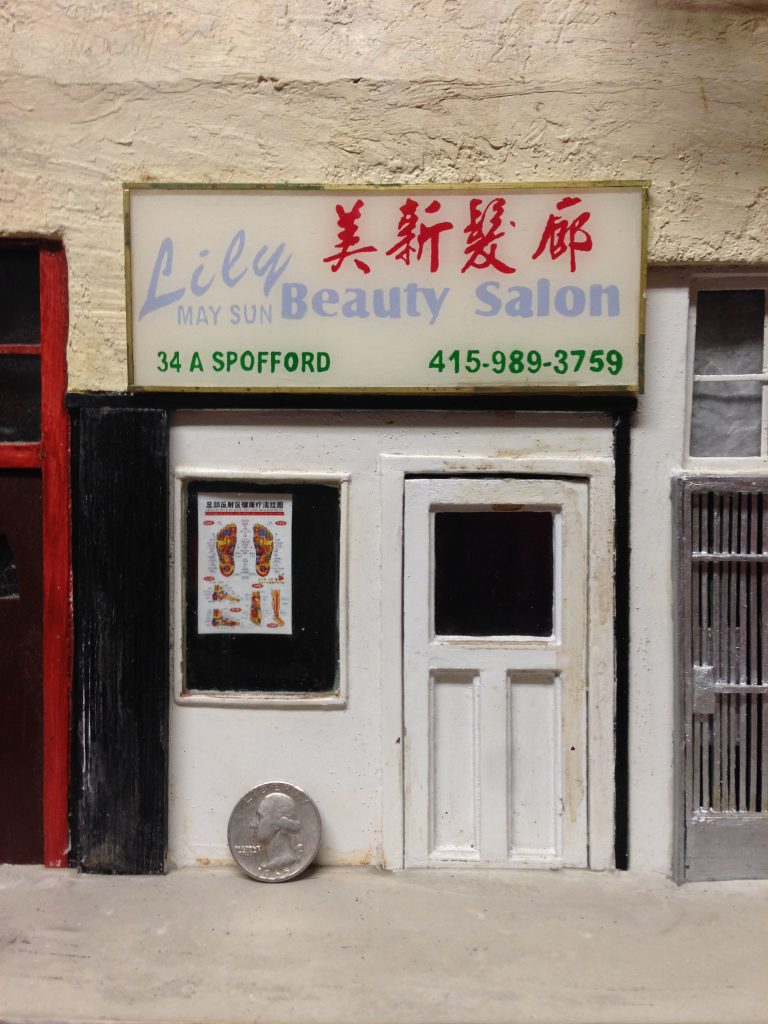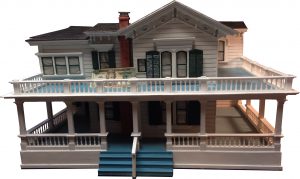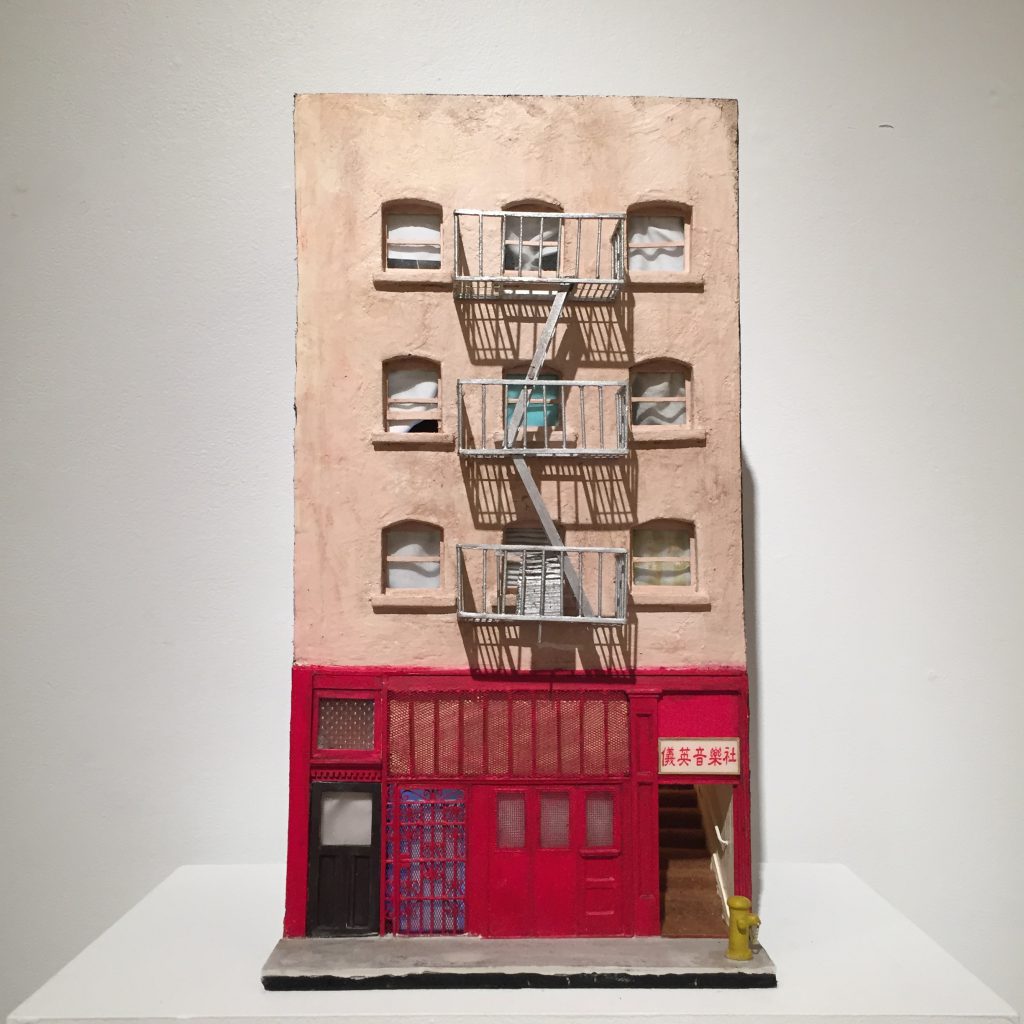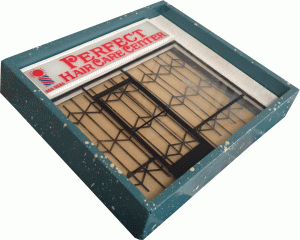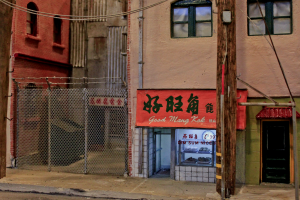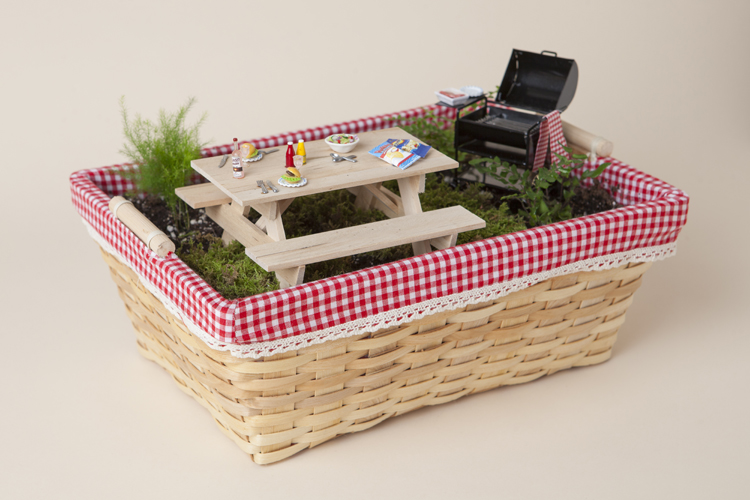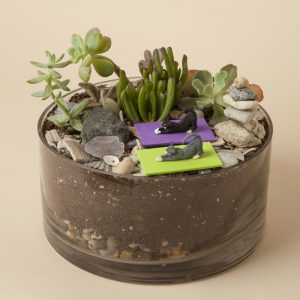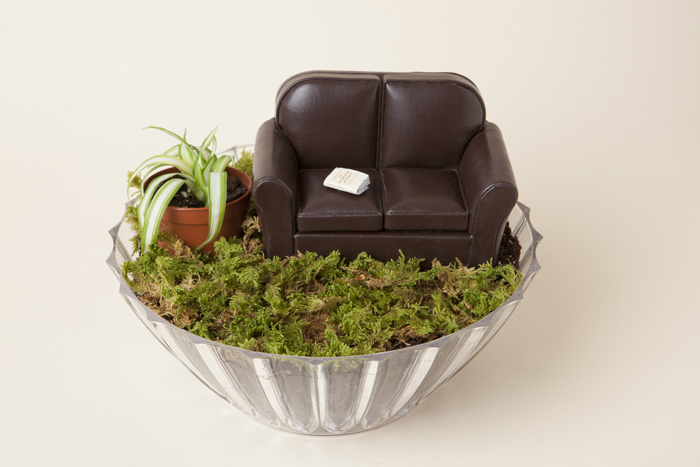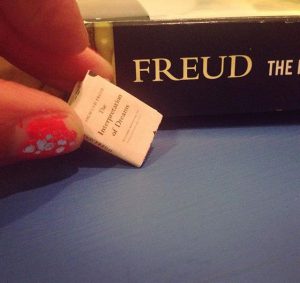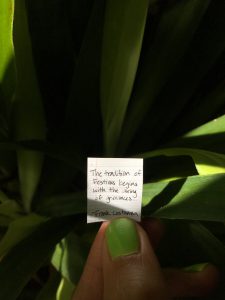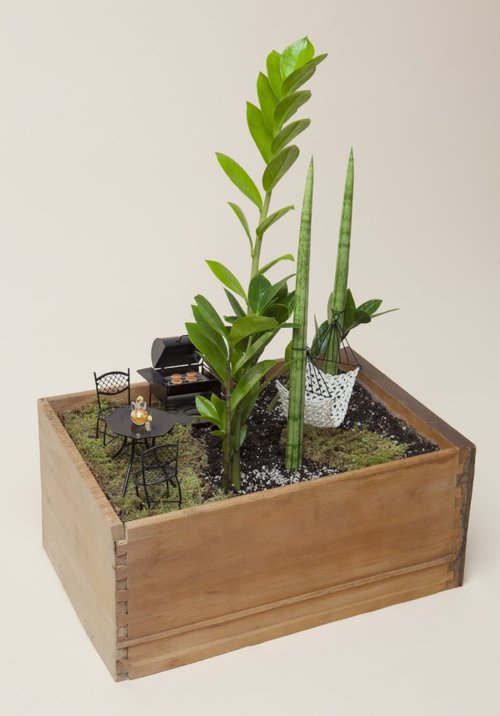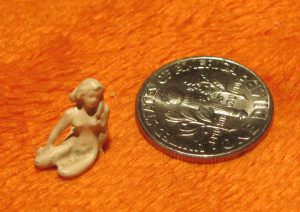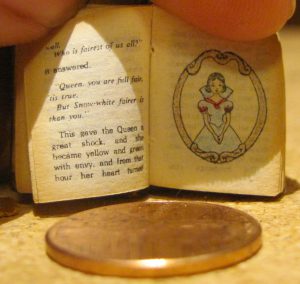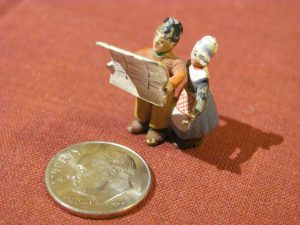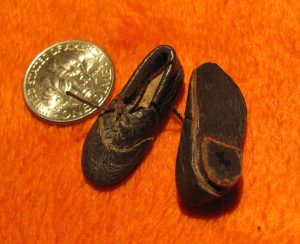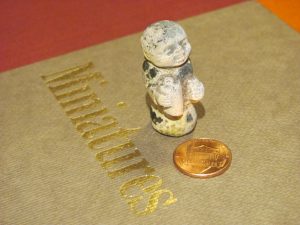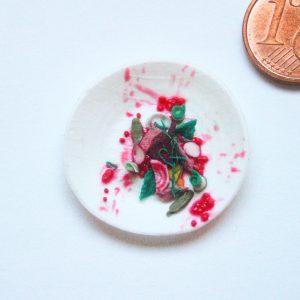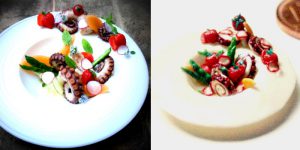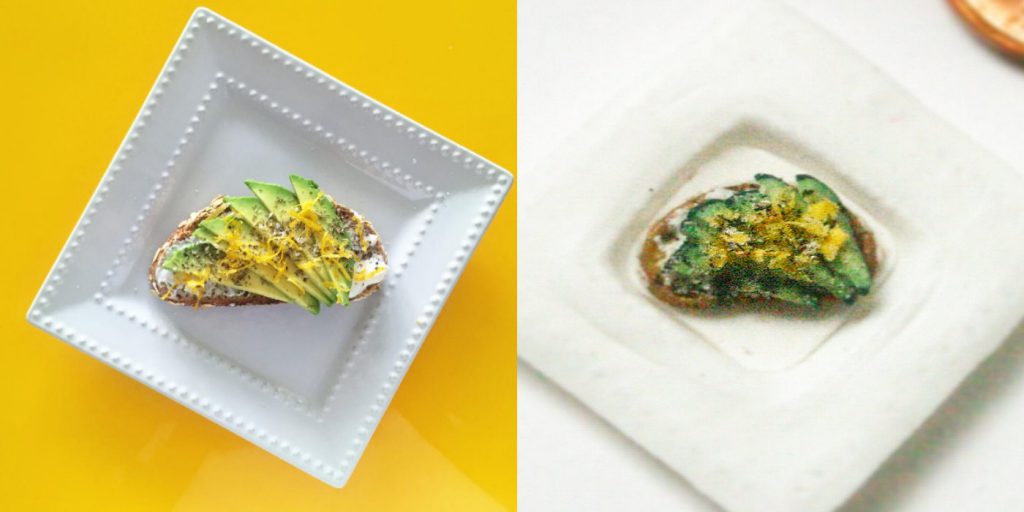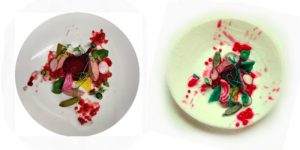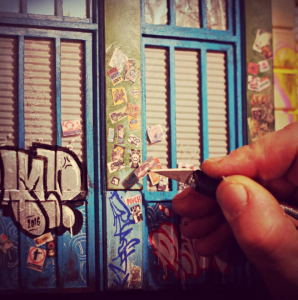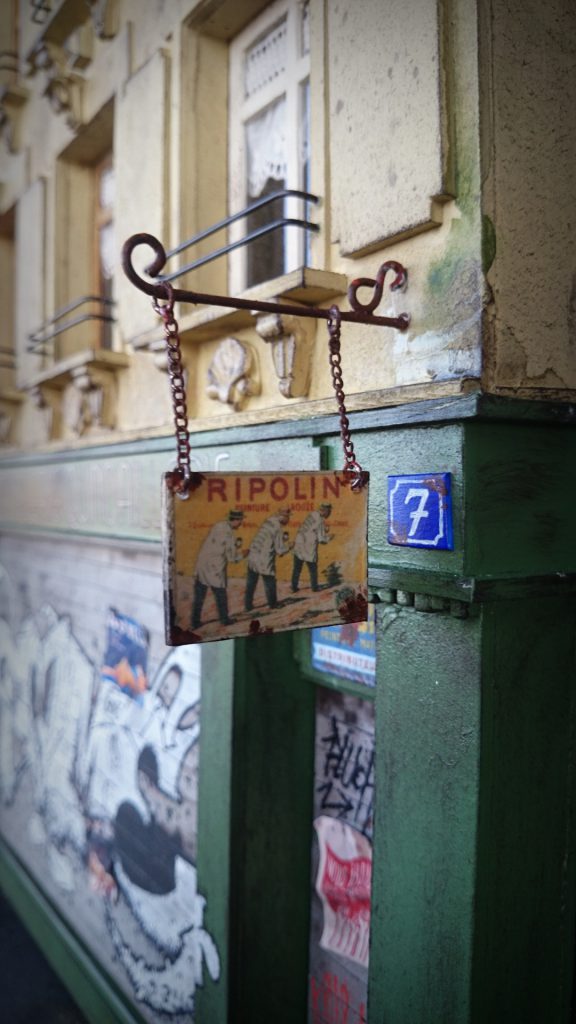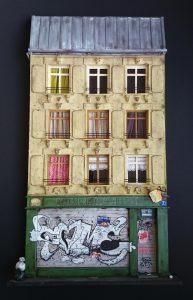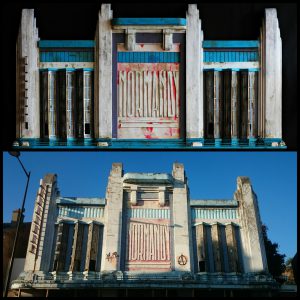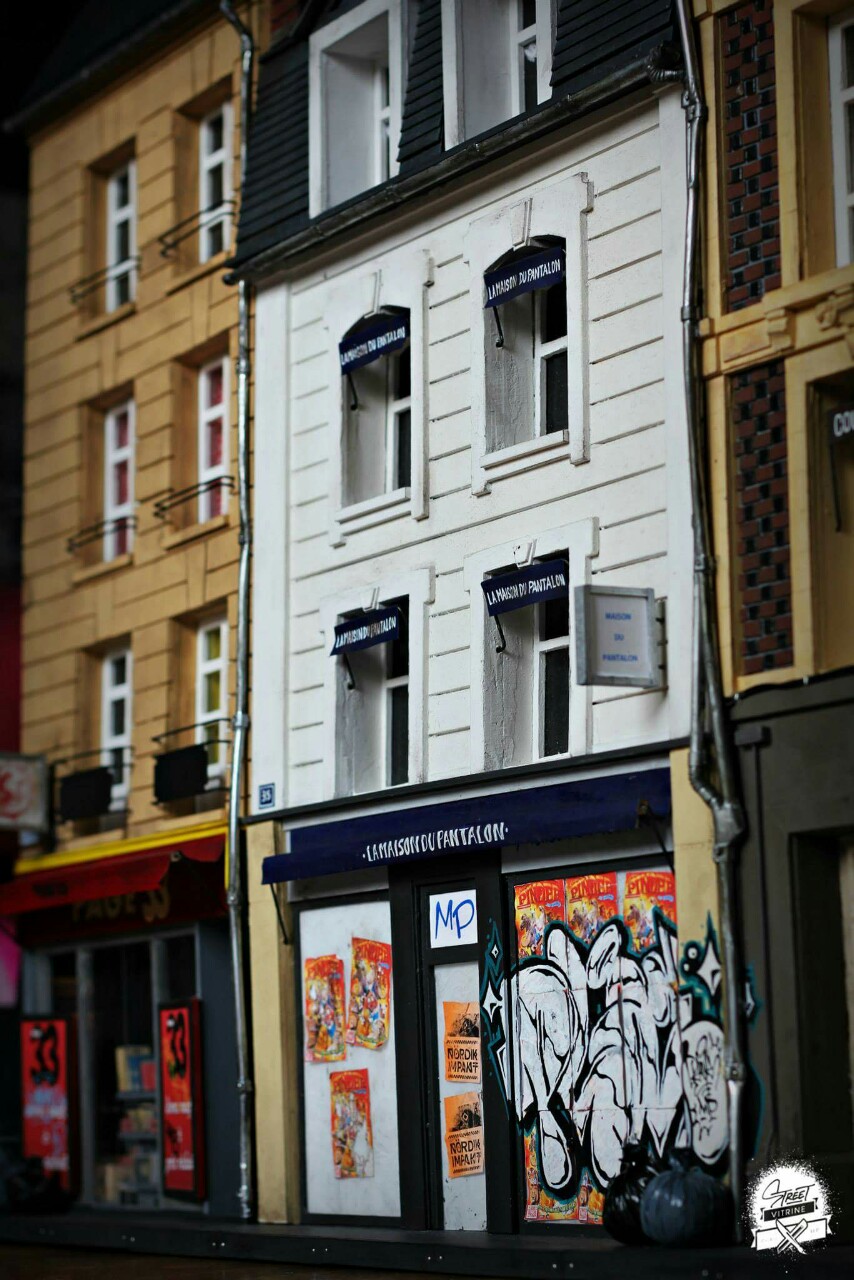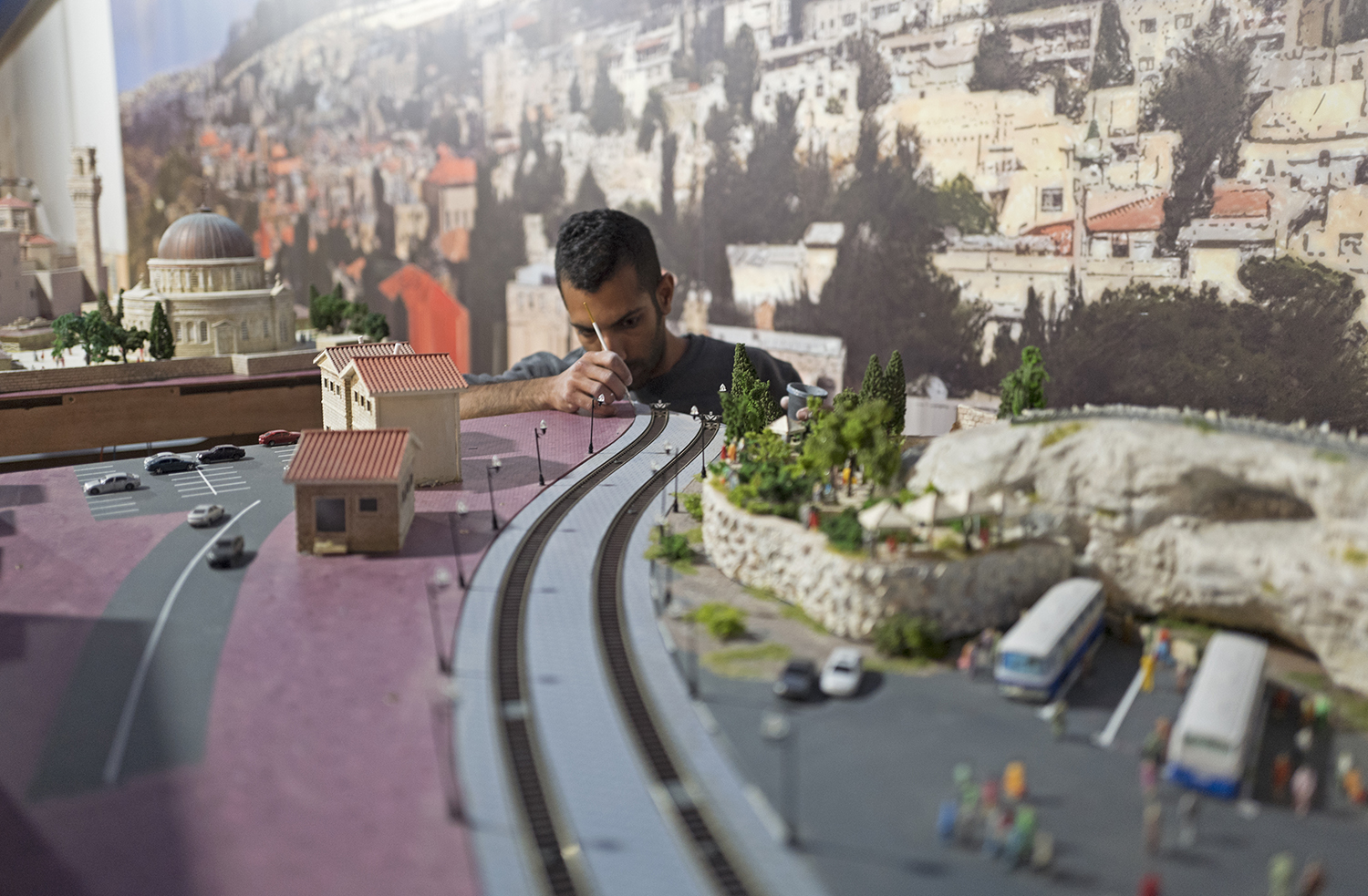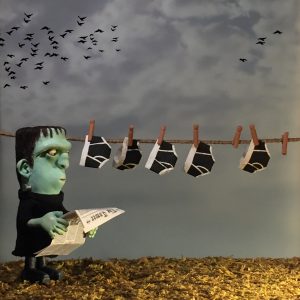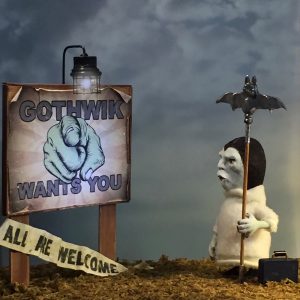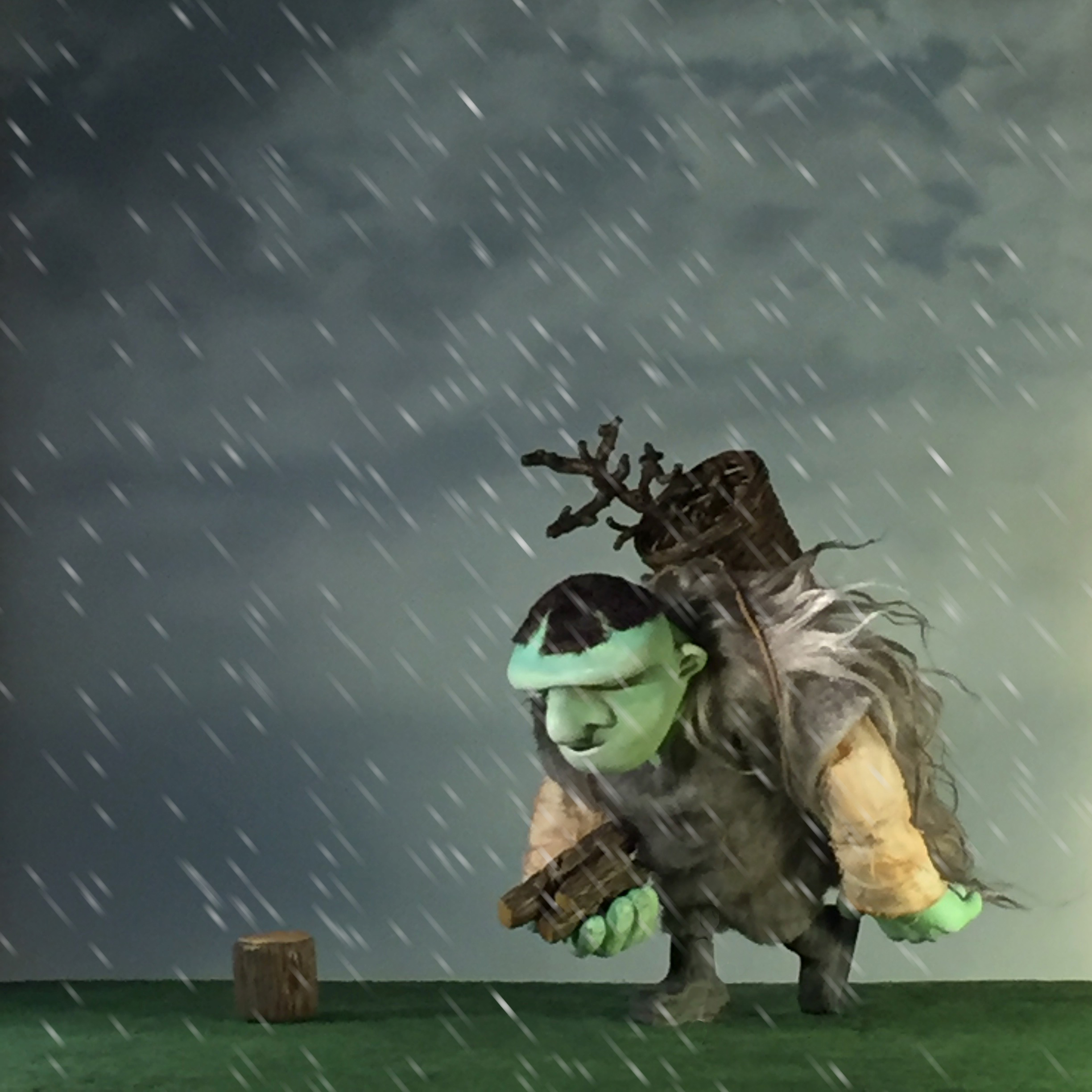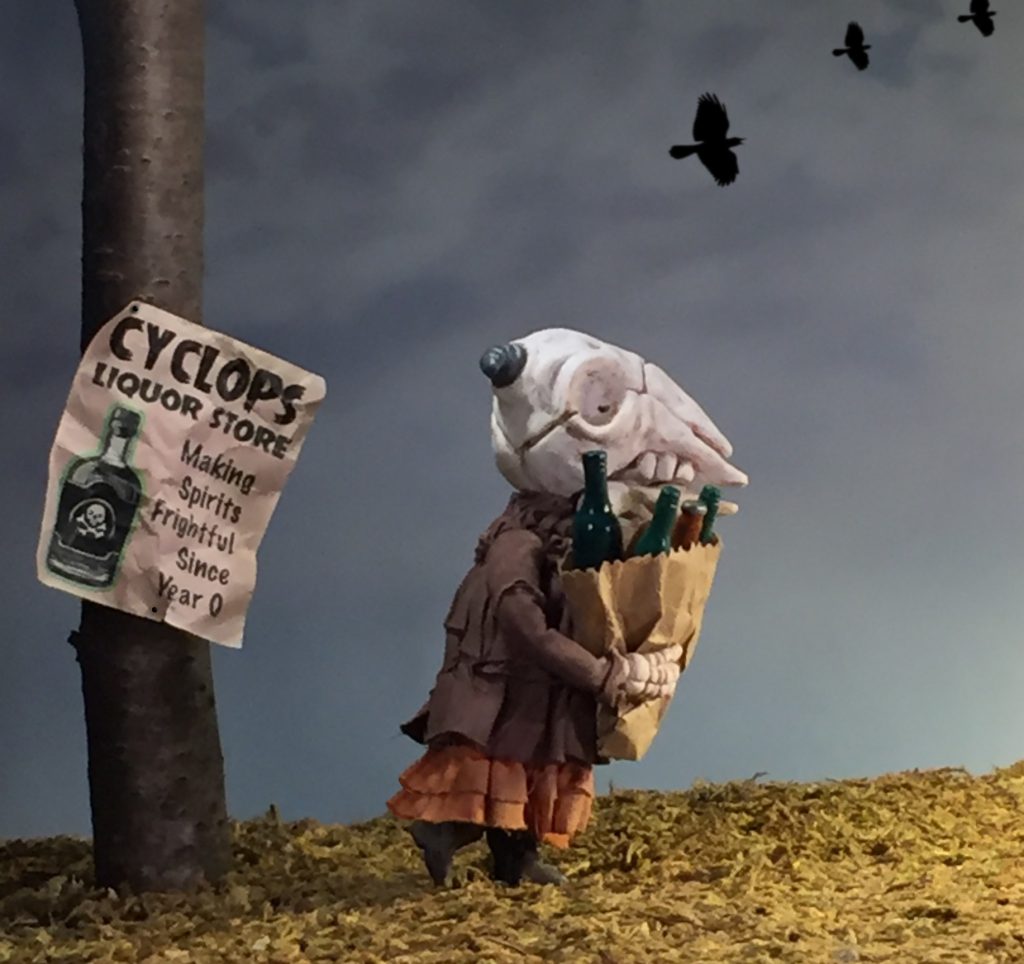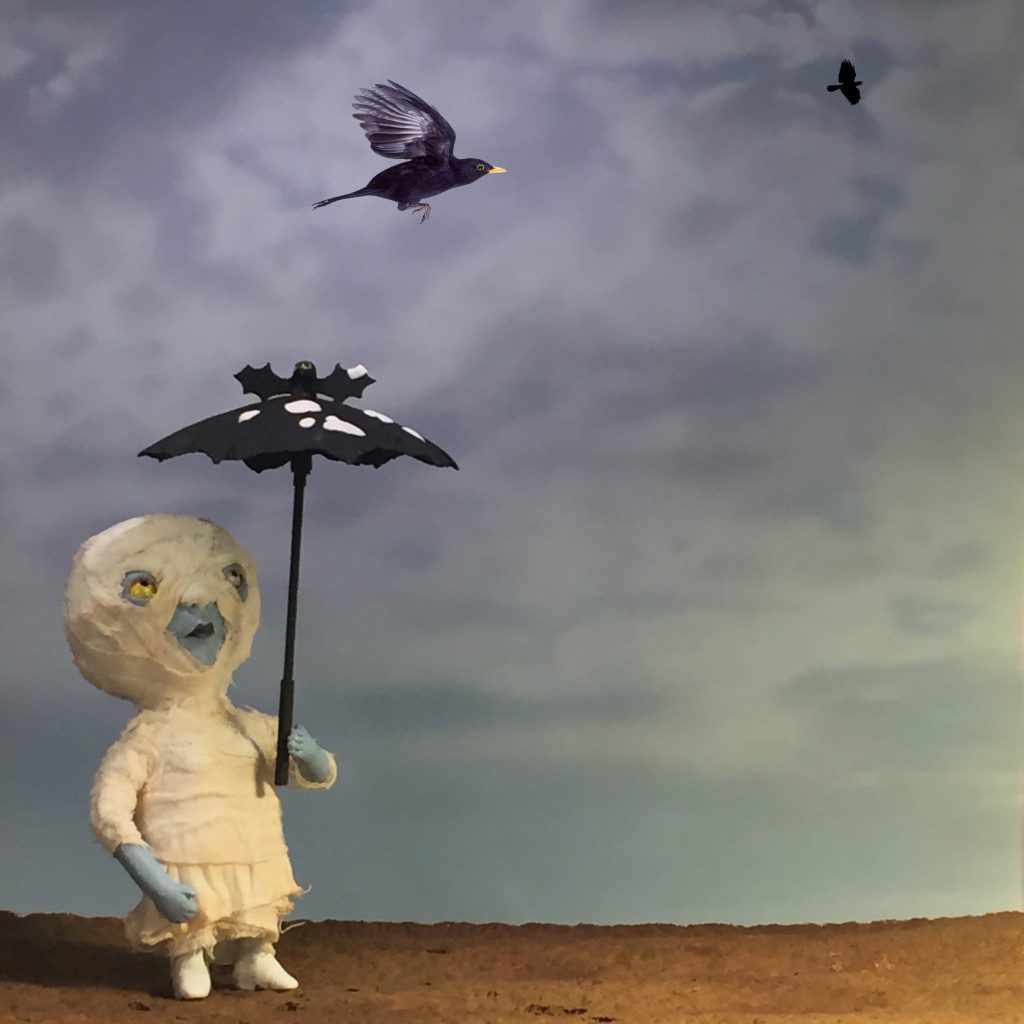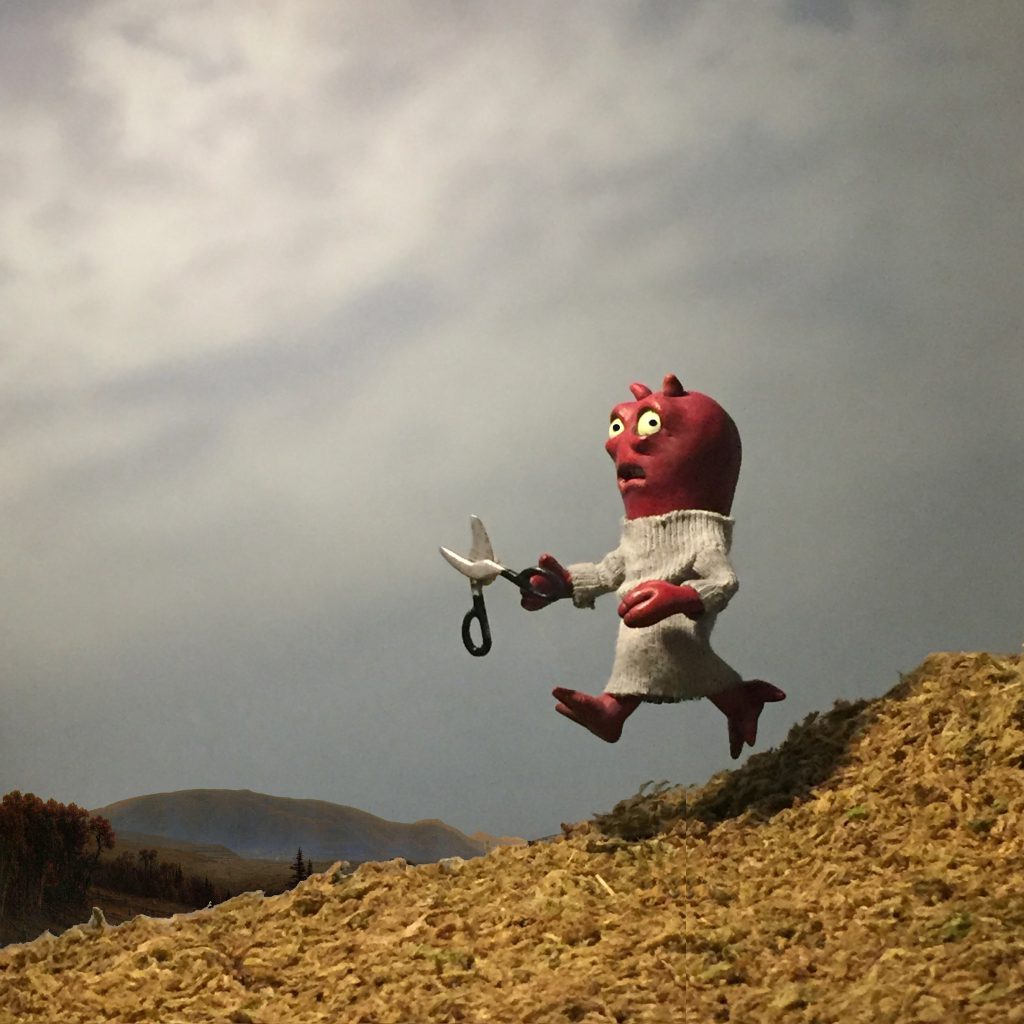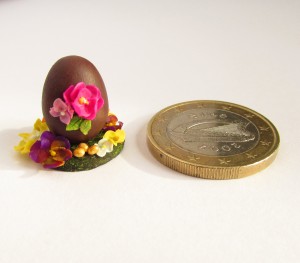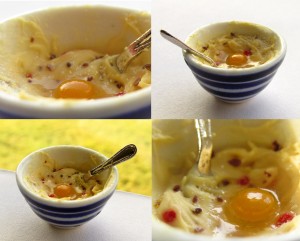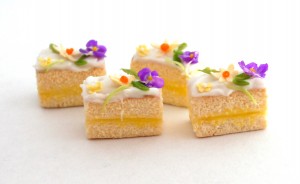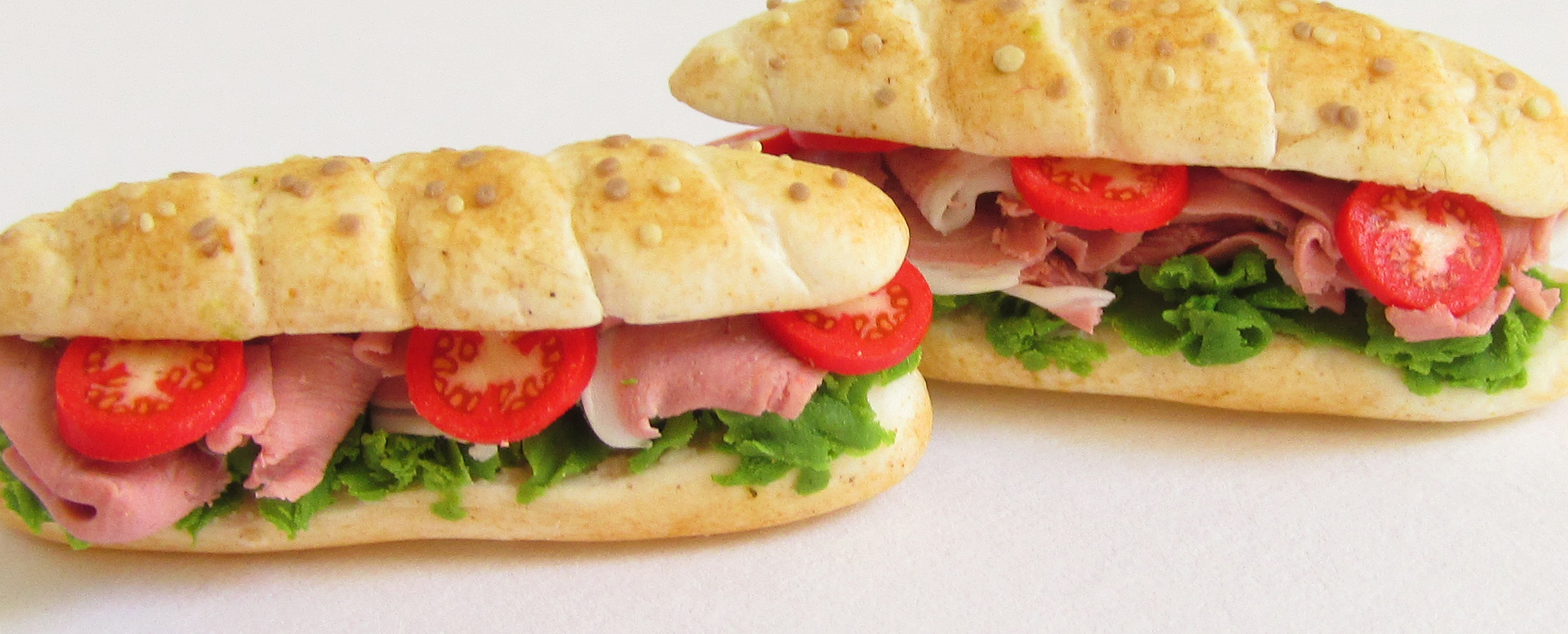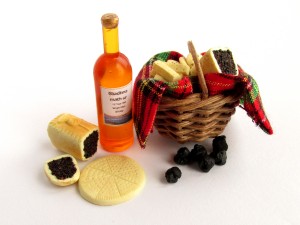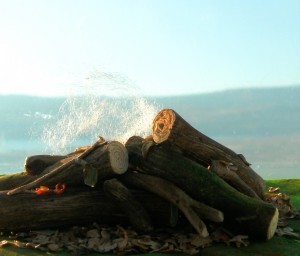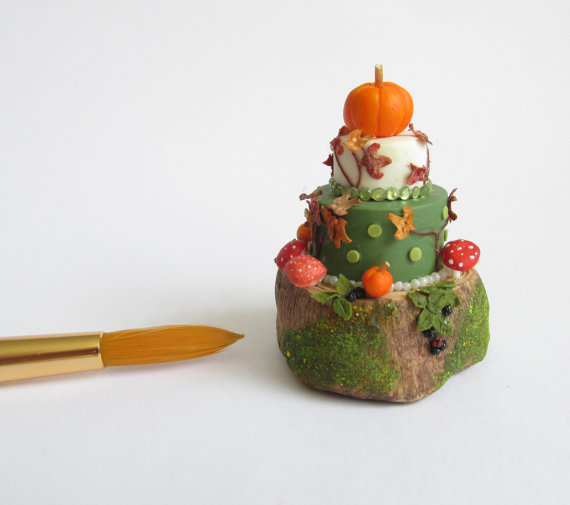A Little Bit of Everything from L. Delaney
| Website | The Haunted Dollhouse | All Dolled Up |
| Etsy | Instagram | Facebook | L. Delaney’s House of Shadows |
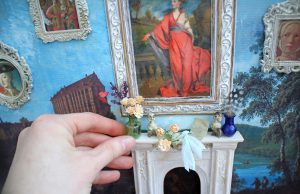 What’s your earliest memory with miniatures?
What’s your earliest memory with miniatures?
I was hanging out with Barbie and Polly Pocket long past the point of it being cool. I especially enjoyed creating worlds for them in our parents’ basement. My sister and I also loved paper dolls. Now all of my miniature show display stuff sits in Barbie’s old corner of the basement. The thought of that makes me smile.
It was my grandparents who first introduced us to dollhouse miniatures. My grandpa created several beautiful dollhouses for the ladies in his life. I remember visiting my grandparents’ house and seeing the dollhouses coming to life in stages. This was in the 1990s when there were many more brick and mortar dollhouse stores. We would make trips to stores in Frankenmuth and Kalamazoo to hunt for tiny treasures. We still have the dollhouses and many of these accessories. I couldn’t have imagined how lasting their influence would be in my life.
What’s a pivotal fashion memory that stands out in your mind?
The most pivotal “fashion” moment of my life was being dressed by Academy Award-winning costume designer Colleen Atwood on the set of Public Enemies. Typically on large films like this, background extras will be dressed by assistants (and later inspected by the designer). But in a crazy twist, Atwood grabbed me and dressed me personally. I was amazed to discover that, although only our 1920s coats and outerwear were showing, she had me in vintage all the way down to the skivvies. Once I was dressed and coiffed, I followed Atwood to the set. So I find myself trotting through the empty streets of Chicago behind this film industry superwoman at 4AM. It was just a completely surreal moment.
Besides being a great adventure, my encounter with Atwood got me thinking about how costume design was this wonderful intersection of my different interests: character study, storytelling, history, and design. I had just graduated from college and frankly had no idea what to do with my life. Living briefly in Chicago and working as a fashion editorial intern, I spent my days applying to everything that interested me on Craigslist: production work, event staffing, assistantships, background extra casting calls… you name it! Nine times out of ten, you never heard back, but the occasional “Yes” responses began opening interesting doors. In a larger sense, my time in Chicago taught me how richly we are rewarded when we put ourselves out there. Throw enough mud at the wall, and eventually something’s going to stick!
More recently in New Orleans, I was tickled to be a featured extra in American Horror Story: Freak Show, where I had my mink “stolen” by that minx, Emma Roberts! Or rather, I should clarify, stolen by the character she was playing. I’m not pursuing acting with serious intentions, but playing the occasional background dressing is sometimes a fun diversion from the daily miniature grind.
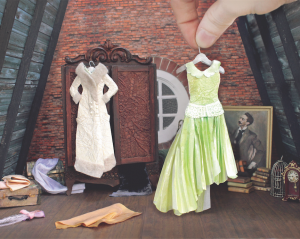 Favorite childhood story?
Favorite childhood story?
As a kid, I always loved ghost stories and I have never grown out of that. I devoured Goosebumps and later Fear Street by R. L. Stine. The adult version of myself is thrilled to have met Stine twice, years apart! The second time I met him was—fittingly enough—in a beautiful old New Orleans’ library filled with mystery writers.
I also grew up pretty obsessed with this reoccurring thing that happens in children’s books where the character bumps their head and wakes up in a different century. I’m super clumsy as an adult, but I think that subconsciously I am just a hopeful time traveler.
As an adult, I’ve developed a different—but no less ardent—appreciation of young adult fiction. Lemony Snicket’s Series of Unfortunate Events is my all-time favorite. Roald Dahl is another favorite. As a child, you appreciate the worlds that Dahl creates, and then as an adult, you become aware of how brilliant (and playful) he is with words.
You excel at crafting a world through the art of storytelling. In a few words, describe your personal relationship with storytelling through mixed media.
For me, creating any sort of world (whether in a theater or a dollhouse or a written story) involves research, procrastination, and then usually a sleepless night or two of feverish making. It’s really extraordinary that color and texture are a language you can harness to communicate a cohesive story. Move the same elements around and you have a completely different tale!
I am always struggling for better mastery of my design process. For me, the hardest part is often sitting down to a project. I can go for days sort of dancing around it in my head before I am able to muster the effort. But once I am absorbed in it, I usually have a hard time stepping away. A lot of the designing is shuffling around the different elements I’ve reacted to in the research process. I try to listen to what the materials are telling me they want to do. I arrange and rearrange and then I have to walk away for a while. And then I return and rearrange some more and suddenly it feels right. Or it doesn’t and this last step gets repeated for a while! When I’ve created something that I know is good, it’s kind of magic in the sense that it feels separate from myself and largely accidental.
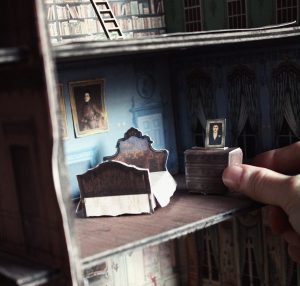 My favorite scene in All Dolled Up is the showboat scene. One night on my way into bed, I thought, “It might be interesting to use this old Venetian glass mirror as the Mississippi River. Let me just try it quickly… well, that looks interesting. I wonder how it would look if I added some moss… Hmm, there should be a white house in the background. Now a cotton candy sky: that’s what this needs… ” In moments like this, the ideas just keep rolling and there is this urgency to get them created, because otherwise you go to bed and the spell is broken. And then all of a sudden it’s 4 in the morning, but you’ve made something you’re puzzled and excited by. And then I usually lie awake in bed for another three hours because I can’t get my brain to turn off.
My favorite scene in All Dolled Up is the showboat scene. One night on my way into bed, I thought, “It might be interesting to use this old Venetian glass mirror as the Mississippi River. Let me just try it quickly… well, that looks interesting. I wonder how it would look if I added some moss… Hmm, there should be a white house in the background. Now a cotton candy sky: that’s what this needs… ” In moments like this, the ideas just keep rolling and there is this urgency to get them created, because otherwise you go to bed and the spell is broken. And then all of a sudden it’s 4 in the morning, but you’ve made something you’re puzzled and excited by. And then I usually lie awake in bed for another three hours because I can’t get my brain to turn off.
And then there are days that slip through my fingers and I haven’t created anything new, because I haven’t had the courage or control to sit down at the desk and I’ve been twiddling my life away on Instagram.
How did you first get started making miniatures?
One year for Christmas, I created a box of personalized miniature accessories for my grandparents’ dollhouse. It included family portraits, their handmade quilts, and a tiny copy of Grandma’s wedding dress.
Soon after, on a lark, I started listing a few miniatures on Etsy. The unusual nature of these (early items included shower loofahs, dog poop, and Playboy magazines) got me some sales and gave me the encouragement to expand my offerings. When I began, I was hopeful that I could produce a bit of extra spending money from my crafting scraps. I didn’t imagine that it would eventually grow into a full-time miniature monster.
In the beginning what kept me making new things, more than sales, was the simple fact that I was having a lot of fun doing it. This has always been the first clue that I am onto something good.
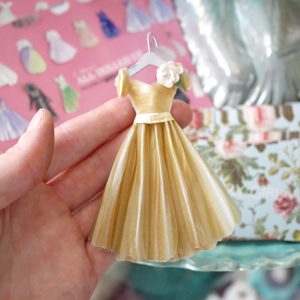 How does your experience in set design and costume making inform your work with miniatures?
How does your experience in set design and costume making inform your work with miniatures?
Miniatures and theater are forms of storytelling that both employ the art of illusion! My miniature work has really sharpened my sense of composition, particularly when it comes to photography. Though I don’t work very often anymore as a set/costume designer, I love being able to say yes to the occasional job that interests me. Last year, for example, I helped to develop an escape room in New Orleans. For those unfamiliar with the concept, players get locked into a room for one hour and must solve puzzles in order to escape. There is usually some theme or narrative connecting the puzzles, and the room is decorated accordingly. Think of it as being locked into a story that you have to find your way out of!
The design approach was similar to designing a stage set. The only difference is that the audience has to interact with the props. Entrapping people into an immersive puzzle was a delight. It was also perfect training for my role as executor to the The Haunted Dollhouse…
Tell us a bit about the concept behind The Haunted Dollhouse.
In New Orleans, truth is stranger than fiction. This is especially true in the case of “The Haunted Dollhouse,” a crime involving a 1920s miniature collection. The dollhouse was created by an inmate at New Orleans’s Asylum for the Criminally Insane and is directly linked to a murder which took place in the French Quarter. Appraisers have spent years trying to crack the cryptic messages hidden in its construction. I’ve spent the past year researching it in the New Orleans archives. The inconsistencies of the murder investigation are so bizarre that I felt obligated to make them public. Amateur sleuths, crime connoisseurs, and miniaturists are all invited to take a crack at solving the case and may subscribe to receive the pertinent documents (and bloody artifacts) via TheHauntedDollhouse.com.
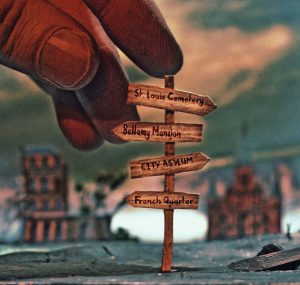 Those brave (or foolish) enough to assist me with the investigation will receive a series of five packages over the course of 1-2 months. Each package contains a cache of clues, miniatures, and archival documents. Clues may take the form of an old telegram, a 1920s newspaper clipping, miniature artifacts, and DIY projects. Each package is like another chapter in the deepening mystery, and as the story progresses, investigators reconstruct a dollhouse which is—egads!—actually a crime scene.
Those brave (or foolish) enough to assist me with the investigation will receive a series of five packages over the course of 1-2 months. Each package contains a cache of clues, miniatures, and archival documents. Clues may take the form of an old telegram, a 1920s newspaper clipping, miniature artifacts, and DIY projects. Each package is like another chapter in the deepening mystery, and as the story progresses, investigators reconstruct a dollhouse which is—egads!—actually a crime scene.
How did NOLA inform or inspire this project?
New Orleans is the most wonderful place to be alive, and apparently also the most wonderful place to be dead. Whenever I set out for my morning coffee, there is the very real possibility of bumping into the ghost of a pirate or Voodoo queen. It’s the most magical city that I know of.
There is just a wonderful energy here. And I don’t mean that in some sort of weird, aural New Age-y way. The history is so thick that you can cut it with a knife and sprinkle powdered sugar on it. And New Orleans doesn’t give a hoot and it knows how to have a good time and it’s filled with ghosts. And of course there’s the marvelous history, food, architecture; streetcars, gaslight lamps, and secrets that my betrothed regularly stumbles upon hidden in the walls of old mansions he renovates… And did I mention the ghosts?
How can miniature enthusiasts become involved as detectives?
Readers should be warned that The Haunted Dollhouse is not for the fainthearted miniaturist. If you are a normal person who does not enjoy 100-year old gossip and a good murder now and again, or if you are immune to the foggy romance of a French Quarter street, then you should close your browser and never think of it again. But if you are that peculiar breed who enjoys blood-tinged pirate treasure, reading through someone else’s mail, and the occasional man-eating alligator, then your phantomly friends are waiting for you over at TheHauntedDollhouse.com.
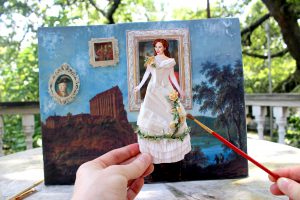 You recently participated in the National Building Museum’s Small Stories: At Home in a Dollhouse exhibition. What was that experience like?
You recently participated in the National Building Museum’s Small Stories: At Home in a Dollhouse exhibition. What was that experience like?
One of the most delightful moments in my career was receiving a plain wooden box from the curator with instructions to fill it with whatever I pleased, so long as what pleased me was miniature!
I’ve spent much of my life wandering around museums and being inspired by them. To have the opportunity to create and contribute an original piece to an institution like the National Building Museum was well beyond my wildest dreams. I enjoyed the entire process of creating my “Dream Room” and it was an incredible honor to attend the preview reception beside my family. On the day of the opening, I snuck back into the exhibit to see if I could catch any of the patrons’ reactions. There was this moment when I watched an older woman lift her little girl up to peer into my scene and it took my breath away. I have so many wonderful memories of days spent in museums with my own family. I don’t flatter myself that the little girl will remember my specific piece, but to witness—and also be a part of—this shared moment hit me in a really emotional way. I think particularly because this whole crazy journey in miniatures has been a legacy of my grandpa’s love. To see it rippling out towards others has me believing that magic is real and every day.
Can you tell us a bit about your inspiration behind The Exile of Prospero?
My Dream Room was inspired by Shakespeare’s play, The Tempest. In The Tempest, the wizard Prospero has been ousted from his rightful dukedom by a usurping brother, and banished to a remote island with his daughter Miranda. In the miniature version that I created for the National Building Museum, I have banished Prospero to a great frozen continent. Here, he has mastered the elements to build a life for himself and his daughter. My dream room captures the moment before the play opens, when—from his great library of ice—Prospero engineers the shipwreck by which he intends to enact his version of justice against the usurpers.
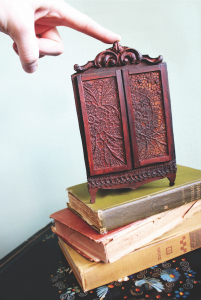 There are so many themes and layers at play in Shakespeare’s great work. It was great fun studying the text and then trying to encode my interpretations into this world. The language of The Tempest is beautiful and I love its meditations on themes of magic and the creative process. One of the other predominant themes that strikes me is how we react to the shaping forces in our life, particularly those beyond our control.
There are so many themes and layers at play in Shakespeare’s great work. It was great fun studying the text and then trying to encode my interpretations into this world. The language of The Tempest is beautiful and I love its meditations on themes of magic and the creative process. One of the other predominant themes that strikes me is how we react to the shaping forces in our life, particularly those beyond our control.
What is your favorite period of art history?
It would be impossible to pick a favorite! Two genres that I return to again and again are surrealism and folk art. But one of the things that I love about art history is that if you go digging into any genre, decade or culture, you are sure to stumble upon something wonderful, something that speaks to you. In this way, art is a great access point to history, introducing you to corners of the world you never imagined existed.
What about your favorite fashion era?
Again, I really couldn’t pick a favorite! I love everything from 18th-century French court fashion to 1920s flapper fashions. It really just depends on the day and my mood. It’s interesting to watch the shifting shapes through the decades and one of the wonderful things about 2017 is that you can draw upon all of these decades for inspiration in your own dress.
In All Dolled Up, one of the delights—and challenges—was deciding which decades of fashion to feature and how they would fit into the story of the two paper dolls! I decided to showcase fashions from the 1880s to the 1920s. The changes taking place in the “ideal” silhouette between those decades is striking. I like to think about how how women’s role in the public domain was shifting as their hemlines shifted. So the paper dolls I created to “model” these fashions are also an homage to those trailblazing women. They are as adventurous as they are fashionable!
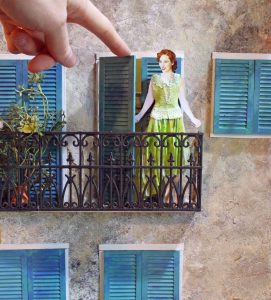 What was your process like in creating your book, All Dolled Up: Creating a Paper Fashion Wardrobe for Paper Dolls, a #1 new release on Amazon.com?
What was your process like in creating your book, All Dolled Up: Creating a Paper Fashion Wardrobe for Paper Dolls, a #1 new release on Amazon.com?
This is the first book I have ever created, and it was a really exciting process. Though it is a DIY book, I wanted to incorporate storybook elements. So miniature aficionados will enjoy traveling through the miniature worlds that I created for the two paper dolls. From circus, to showboat, to seance parlor, there is something in there for everyone in there!
Do you have a favorite book?
I have always loved to read and I would have a really difficult time narrowing it down to just one book! My favorite genre is Gothic fiction. I love its wrecked old mansions, dark family secrets, and, of course, ghosts (or at least the suggestion of ghosts). Angela Carter, Shirley Jackson, Edna Ferber, M.R. James, Steven Millhauser, Italo Calvino, Ayn Rand, Donna Tartt, Ray Bradbury, and Daphne du Maurier are just a few of my favorites. And I know I am forgetting some old friends on that list.
What about a favorite book you’ve made in miniature?
My very favorite tiny book is the one holding a key in its secret compartment! The Secret Garden would have to be another favorite.
What inspires you?
There is inspiration everywhere. In conversations with friends, museum visits, antique stores, Sunday matinees, historic places…I’m also enormously inspired every day by this community of creative people living in New Orleans. And New Orleans itself. The architecture, music, art and history have a lot to say.
What keeps me creating is the joy that I find in engaging with the world, whether through my art or my friendships. Every day I wake up to the possibility that someone will discover my Etsy shop, or that I will receive a strange request from a museum, or a fateful email from a book editor or dailymini… I get to do so much playing! And that’s not to say that it isn’t enormously difficult—or terrifying at times—but it is a joy. And I’m proud to put my name on each day, whether it’s been a success or a failure.
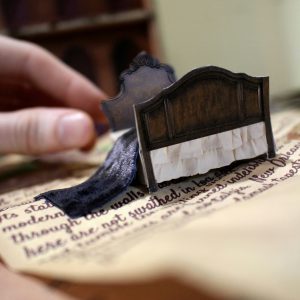 What advice would you give to new artists, beginner miniaturists, and dedicated hobbyists about taking their passions to the next level?
What advice would you give to new artists, beginner miniaturists, and dedicated hobbyists about taking their passions to the next level?
First, you have to work with what you have. Too many people fixate on what they lack. Maybe that’s money, or photography skills, or a clear vision for their endeavor. When you move forward to confront those “obstacles,” you discover the strategies for conquering them. If a task seems daunting, break it down into daily goals that are achievable. You just have to commit to doing it, which means figuring it out as you go, rather than waiting until you have all the answers.
When I started on Etsy, my pictures were dark and blurry. I didn’t have any real money to invest in my business and I didn’t know anything about shipping costs, taxes, or designing a website—or anything, really! But you pick up so many skills day by day just in the doing. And if you keep working on it every day, you build steam. All I started with was a pile of scraps. Seriously.
You’re probably also afraid that you are going to fail. You are! Get over it. Any “success” I’ve achieved has been the product of dozens of “failures.” You start to realize that a better word for failure is “lesson.”
Favorite miniature you own by another artist?
My favorite miniature that I own by another artist is a pair of funny glasses by Wright Guide Miniatures. They look like the classic disguise gag glasses, complete with a mustache, eyebrows, and a nose, but they fit on your pinky. It just about kills me dead. I am always really blown away by their presentations at the miniature shows. They are a beloved fixture in the miniature show circuit: talented, creative, and pleasant to boot.
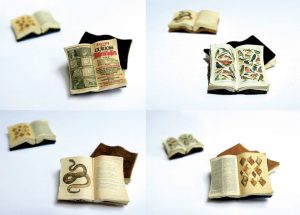 Favorite artists or designers you’d like to mention?
Favorite artists or designers you’d like to mention?
My next book will feature a puppet created by my very talented friend—and puppeteer—Marte Ekhougen. Marte designs sets for theater and has a line of handmade toys and creatures called Doctor Superhelga. Her work is extraordinary. Collaborating with her is an honor that I have dreamed of for a long time.
What is the most memorable miniature you have ever seen?
I am endlessly fascinated by (and non-judgmental of!) the projects people bring to me. I have seen everything from miniature morgues to miniature sex dungeons. Yes, miniature sex dungeons are a thing.
What is your hope for the field of miniatures?
I think anyone involved in miniatures will recognize that it is a hobby which bridges generations in a really wonderful way. Grandparents, parents, and children can share the delight of creating and decorating a dollhouse together. I hope to see more younger people taking up the hobby. I think that miniature artisans who are really entrenched in the world would do well to harness the power of social media and technology to bring their craft to wider audiences. But I also don’t think that miniatures will be leaving the scene any time soon—they’ve been a feature in every chapter of art history!
What do you want to see replicated in miniature?
My tiny studio is in the back of New Orleans’s Century Girl Boutique, the world’s loveliest vintage clothing store. I would love to create a miniature replica of Century Girl and fill it with my tiny paper dresses! It’s on the list.
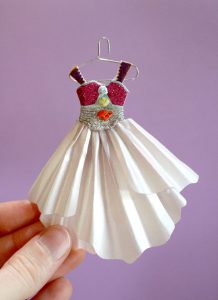 Why miniatures?
Why miniatures?
I have all of these stories and imaginary worlds rattling around in my head. It’s the best way to bring them out into the light of day.
What’s to come from Lauren George?
I’m in the midst of a second book for Dover and I’m also busy preparing a sequel to The Haunted Dollhouse. This year, I’m excited to be bringing more artistic collaborators into the studio for some of my projects. In addition to Marte’s puppeteering, artist Amanda Shafran is collaborating with me to create several original paintings for the book. Stay tuned!
What miniature show will you be at next?
My mom and I have always really enjoyed attending Philadelphia Miniaturia. We make it a road trip from Michigan and we stop at all sorts of interesting historic sites and towns along the way. Other work obligations kept me from attending this past year but I’m hoping to return to the 2017 show.
Words you live by?
Growing up, my parents always told us that the world is there for those who show up and that if you work passionately at what you love, everything else (rent, soulmate, paying off your student loans) will follow. That sort of unquestioned confidence from a parent or mentor cannot be overstated. There were so many moments when I could not see it for myself and needed to hear it from others.
Watching me sell dollhouse miniatures probably tested my parents’ certainty on these points, so it’s been fun to have them by my side for the past year’s big miniature adventures. It was especially gratifying to peer into the Tiffany holiday windows with them, to celebrate my book’s launch and to toast the museum exhibit opening in D.C. last spring. They’ve earned it!
Favorite miniature quote?
“We are such stuff as dreams are made on, and our little life is rounded with a sleep.”
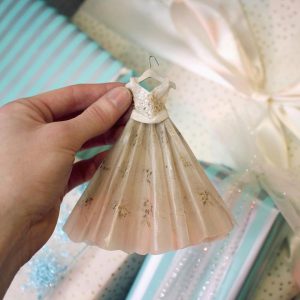 Other activities you enjoy?
Other activities you enjoy?
I love taking road trips and uncovering curious corners in the towns I visit. I also love throwing and attending costume parties! Luckily, our apartment is in a big old haunted mansion and very well suited to Halloween parties. And there is no shortage of enthusiastic masqueraders in New Orleans!
What do you want miniature enthusiasts to know about you?
Historically, New Orleans is a haven for artists and eccentrics. Tennessee Williams called it the “last frontier of Bohemia.” And I suppose he would know, having conjured Blanche DuBois out of its thick, steamy air. My Instagram and Facebook are a window into what it is like to live and work here as an artist. In addition to my miniature work, I try to highlight the places and people of New Orleans that inspire me. If a vintage-wearing, ghost-hunting miniaturist sounds like your cup of tea, then I hope you’ll join me for the adventure!
Would you like to share a dailymini exclusive with readers?
I am already busy working on my second book with Dover! It will be a departure from the frothy, pastel prettiness of All Dolled Up. Creepy, with a touch of madness. If you have any curiosity on how a book gets made, from the dreaming to the editing, I will be posting frequent process updates on my social media pages and in my newsletter.
And if you ever find yourself in New Orleans, be sure to stop by my secret lair in the back of Century Girl Vintage Boutique!
Lauren Delaney George (whose alias is Lady Delaney or L. Delaney) is originally from Kalamazoo, MI. She’s currently haunting New Orleans, Louisiana. You can see more of her work on the Lady Delaney website, and follow her adventures on Instagram and Facebook. To add an L. Delaney miniature to your collection, head on over to Etsy. Learn more about and purchase All Dolled Up on Amazon. You can pre-order L.Delaney’s House of Shadows on Amazon, before its release in February 2018.
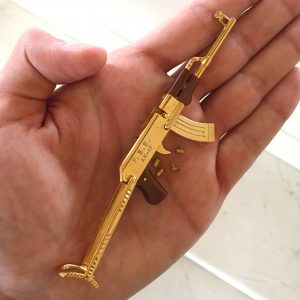 Tell us a bit about Miniature Army.
Tell us a bit about Miniature Army.  What’s your favorite miniature weapon?
What’s your favorite miniature weapon?